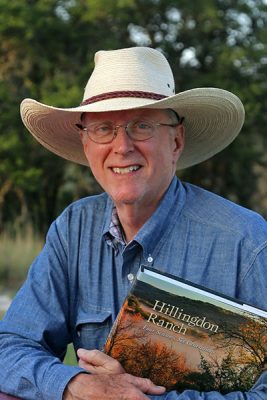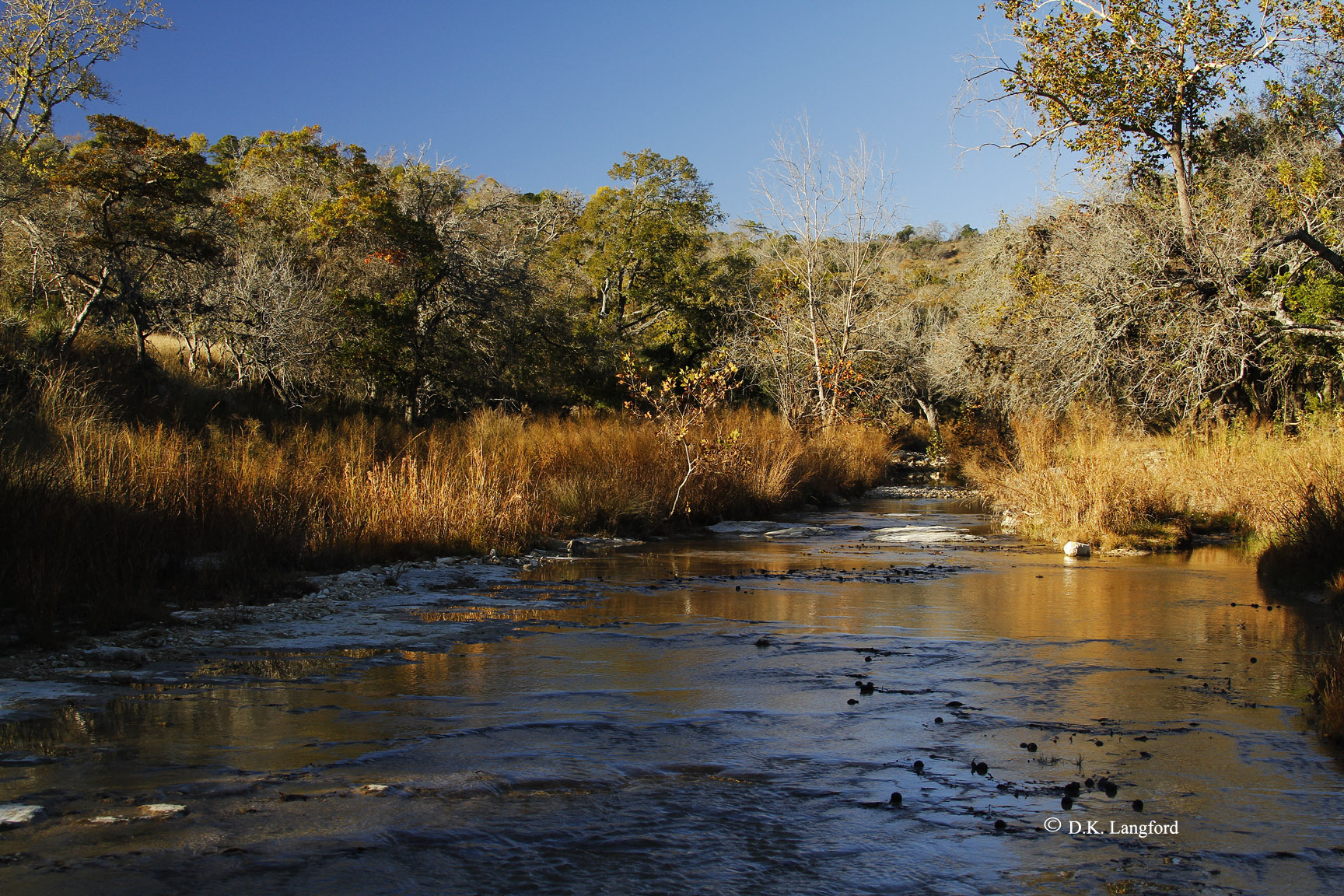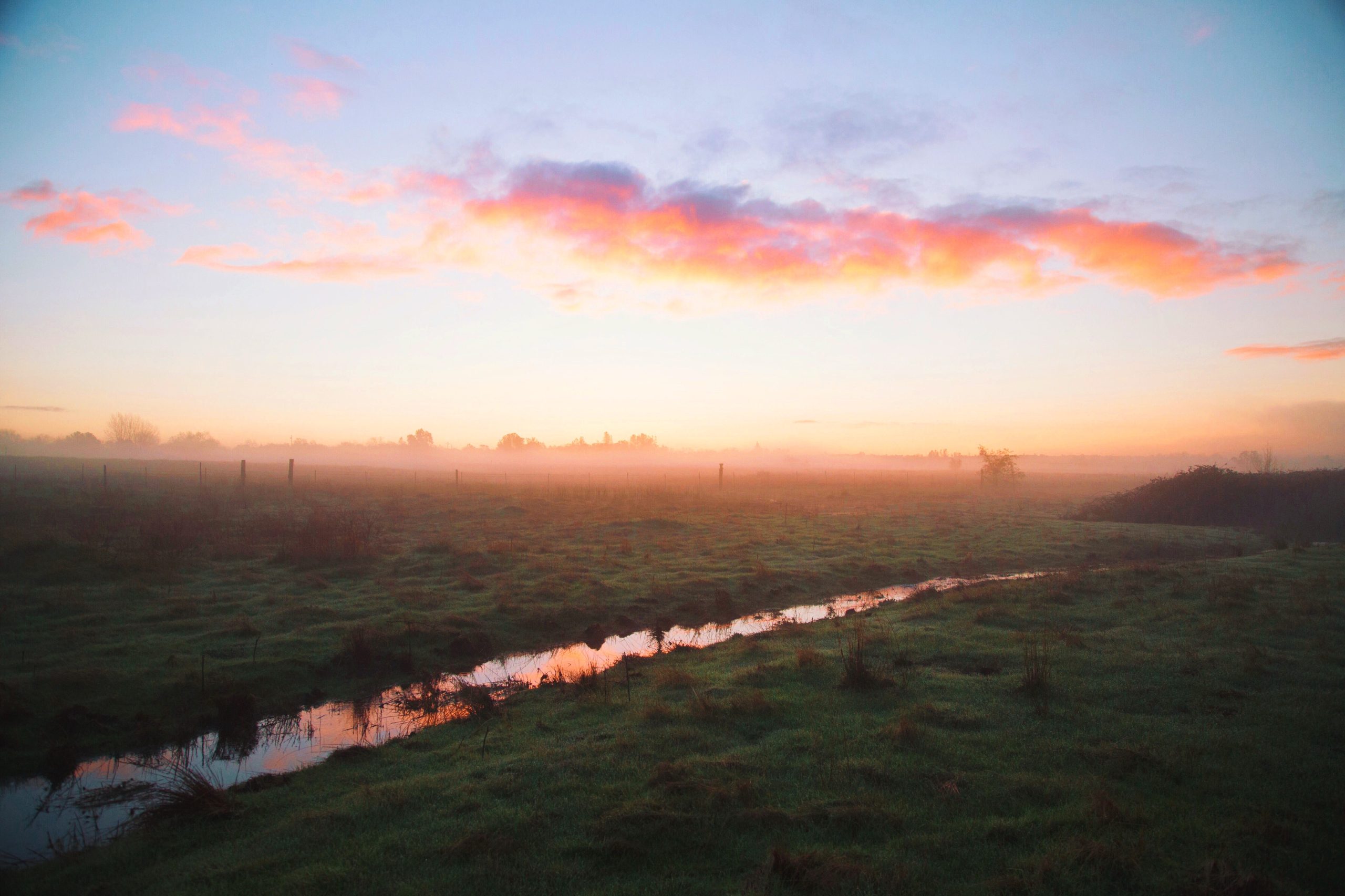A cause-and-effect case study of what happens when urban and suburban migration collides with rural areas and natural resources
by LWP Staff
Water is a limiting factor in soil chemistry, agriculture, wildlife management—and life.

David K. Langford, retired CEO of the Texas Wildlife Association, respected Texas conservationist and noted nature and cowboy photographer. Photo by Lillian P. Russell
“The availability of natural resources, particularly water, is the foundation of our entire economy and our way of life,” said David K. Langford, retired CEO of the Texas Wildlife Association (TWA), noted Texas conservationist and nature and cowboy photographer who lives in Comfort, Texas. “And yet, most people take the availability of water for granted until it starts to disappear.”
Texas is coming to face the truth that has become a harsh reality for much of the western U.S. with California as a notable example. While parts of Texas have always been desert, most of the state received more abundant rainfall disrupted by the periodic droughts that have always characterized life in the Lone Star State. With changing weather patterns, the dry line demarcating the desert climate to the west is seemingly moving farther east, throwing more of the state into extended drought.
To compound this effect, Texas is experiencing exponential growth that began in the mid-1990s and just continues to pick up speed. Today, 1,400 people move into the state every day, which translates into more than 500,000 new residents annually. To accommodate that growth, approximately 660 acres of working land is being lost to development, placing more demand on the remaining open space to produce life giving air, water, food, fiber and other essential ecosystem services as demand for those goods increase apace.
The Texas Hill Country, region that extends north and west of Austin and San Antonio to portions of Concho, Tom Green, Irion, Sterling, Glasscock, Reagan, and Irion counties in the west, has often been compared to Tuscany because of its rugged beauty. Previously, the domain of hardy pioneers who raised sheep, goats and cattle, the central Hill Country, which is closest to Austin and San Antonio, has become one of the most sought-after residential destinations in the state.
“In the aftermath of COVID, as people realized the value of ‘elbow room’ and pioneered ways to work from home, the flood gates of new residents descended on rural Texas,” Langford said.
Unlike many places in the United States, the Texas Hill Country provides a cause-and-effect case study on what happens when urban and suburban migration collides with rural areas and natural resources.
The region sits atop the Edwards Plateau, an area characterized by shallow soils overlying porous limestone formations known as karst limestone.
Two aquifers, the Edwards and Trinity, hold water within the karst. The aquifers are relatively shallow and recharged directly or indirectly by the rain that falls. Crystalline springs bubbling to the surface from the underlying aquifer not only define the landscape but their flow—or the lack thereof— provide visible evidence of the aquifers’ health.
“Our springs are the proverbial canaries in the coal mine,” said Langford. “And they’re struggling to sing. Many of them have stopped.”
Victims of the drought and over pumping include Jacob’s Well, an iconic spring-fed swimming hole outside of Wimberley that quit flowing for the fourth time since 2000. To put that in perspective, the spring didn’t quit flowing in the seven-year “drought of record” that gripped Texas in the late 1940s through the mid-1950s and stopped production on 50 percent of the state’s farms.
The state’s spring-fed rivers including the Guadalupe, Frio, Llano and more have fallen victim as well. None are flowing. This not only impacts cities and towns, but life in the estuaries of the Gulf of Mexico.
To explain the relationship between the aquifers and the springs in the Hill Country, Langford uses the analogy of a bathtub with an overflow valve.
“The aquifer is the bathtub, and the springs are the overflow valve,” Langford said. “When the bathtub is full the overflow spills out through the valve, but when the bathtub empties nothing flows through the valve.”
Langford, who spent a portion of his early career in real estate, understands and appreciates the need for development and the urge of people to live in a beautiful, natural setting like the Hill Country.
“The Hill Country is a special place—and I can’t hold it against people for wanting to live here,” Langford said. “My family has chosen to call this place home since the late 1800s, but there is a right way and a wrong way to leave a mark on the landscape.
“The challenge is achieving sustainability by recognizing the limits of resources, balancing supply and demand, and empowering landowners, new and old, with education, so they can—and will—responsibly steward the resources in their care.”
Two Experiences, One Concern
Langford’s next birthday will mark his 82nd lap around the sun. His roots are seven generations deep in the Texas Hill Country, a place that’s beauty belies its harshness. Thin soils and periodic droughts, some extended, have long tested the fortitude and resilience of those trying to coax a living from the land.
When his great grandfather Alfred Giles founded Hillingdon Ranch near Comfort in 1886, it was the presence of water that offered the promise of a future. The original 13,000-acre ranch, which is still a working ranch producing pedigreed Black Angus cattle, dual-purpose sheep and Angora goats, is home to numerous crystalline springs that for millennia bubbled up unbidden out of the ground from the underlying Edwards Aquifer.

Spring-fed Block Creek, the primary water source on Hillingdon Ranch that supplies the nearby Guadalupe River, during a normal flow about two years ago. by David K. Langford/Western Photography Company
In fact, one of Langford’s earliest memories and his first lesson in conservation came from a spring just down from his grandparent’s home on the ranch. As the second oldest of 13 cousins, the job of keeping the family water bucket full fell to Langford and his older cousin.
Throughout the day, the bucket was emptied as people quenched their thirst and performed household tasks. Every empty bucket required the cousins to walk to the spring, fill the bucket and carefully carry it back to its perch on their grandparents’ kitchen table.
“Our family depended on that water,” said Langford. “Each trip etched the outline of the bucket handle into my palm and the importance of water into my subconscious. Water is not something to be taken lightly—it was essential to our life.”
Today, he and his wife Myrna, live on their portion of the family ranch in a home restored by Langford’s mother in 1960. For the first 40 years of its existence, the domestic well that supplies their home maintained a relatively steady level of 125 feet.
In the last 20 years, the well has dropped 80 feet. Their personal water use hasn’t increased. They are on a waiting list for the water well driller to deepen their well to reach the receding water table.
They are not alone. A long-time neighbor on another historic ranch is hauling water daily to fill a 50-gallon storage tank on her porch because her well has gone completely dry. She, too, is on the waiting list for the drillers.
Since the Langfords moved to the ranch full-time in 2000, two things have changed. First, the rainfall, never reliable, has become more unpredictable. According to Langford, who has family weather observations dating back to the 1880s, the region has been in a constant state of drought except for flood events, the largest of which occurred in 2002 and 2004.
On the greater Hillingdon, the family has about 75 water gaps [small stretches of fence that cross creeks, streams and other water courses and are designed to washout in the case of high water to protect the integrity of the fence on either side]—and the family has fixed very few water gaps in the past 19 years. Historically, repairs were a common occurrence.
The second factor is growth, locally and regionally. In 2000, the population of Kendall County, home to Hillingdon Ranch, was 23,980 and today it is 47,540. Bexar County, home to San Antonio about 47 miles to the east, has experienced even more extreme growth. In 2000, county residents numbered 1.39 million. Today, there are 2.12 million residents.
“While the rainfall patterns have changed, we’ve had enough rain to maintain the landscape under our family’s conservation-oriented management,” Langford said. “The major impact on our water is outside our control. More straws are drinking out of the same cup and the cup is being drained at an unsustainable rate.”
Mark Harman, Texas Managing Broker for Live Water Properties based in Fredericksburg, Texas, moved to the Hill Country with his wife Pam about 15 years ago. As former Dallasites turned small town residents, they have had a unique view of the changes around them.
Harman’s father introduced the couple to the region when he sold his oil and gas business based in East Texas and retired to Lakeway, a lakefront community west of Austin that is a gateway to the Hill Country. He also purchased a ranch in Gillespie County, just outside Fredericksburg.
Over time, at the elder Harman’s invitation, the couple began exploring the Texas Hill Country. Eventually the couple decided to trade in their fast-paced life in Dallas, where they were regulars on the society pages, for the slower pace of Fredericksburg, a much smaller community.
“Before we came here Pam and I were incredibly social, serving on a lot of charitable boards, so our calendar was packed with dinners at starred restaurants, cocktail parties and black-tie galas,” Harman said. “I wasn’t convinced that slower was better, but to my surprise it captured Pam’s imagination.”
And in 2008, they took the plunge. Buying a house in Fredericksburg, they found themselves doing things they would have never done in Dallas such as hanging a porch swing where Pam could enjoy her morning coffee as she watched the sun rise. At the time, Fredericksburg was in the earlier stages of its reinvention from small German farming community to must-see place-to-be. New restaurants, wineries and boutiques were beginning to pop up.
Over the past 15 years, coinciding with Texas’ growth, the popularity of Fredericksburg and the surrounding Hill Country surged. Fredericksburg is now a destination for tourists from across the state, nation and globe. It is now one of the state’s most coveted zip codes.
The Harman’s have since staked a claim on acreage outside of town to enjoy privacy and elbow room within an easy drive of Fredericksburg’s amenities. While as a ranch broker, Harman is committed to sharing this corner of paradise with new residents, he is concerned that the unplanned growth may cause the fragile ecological region to be “loved to death” as the natural resources are overtaxed.
“Water is precious, but 90 percent of the people I talk to have this misperception that it just flows out of the tap like magic—and that it’s everywhere and will be forever,” Harman said. “It’s a resource that has to be managed and safeguarded through responsible use.”
Of course, its relative scarcity, makes water, especially live water an extremely valuable asset. The only upside for an extended drought is that the conditions make it obvious which is the most persistent live water.
“For those who want to steward the valuable bounty of live water, now is the time to start your search,” Harman said.
The Biggest Straw
In Texas, groundwater use and surface water use are regulated differently. Surface water is deemed a possession of the citizens of Texas and governed by the Texas Commission on Environmental Quality.
Groundwater, on the other hand, is the property of the person who owns the land above it. Texas is the last state to manage its groundwater under this law known as “Rule of Capture.” As described by the Texas Supreme Court, the Rule of Capture “essentially allows, with some limited exceptions to pump as much groundwater as the landowner chooses, without liability to neighbors who claim that pumping has depleted their wells.”
In the 120 years since the state adopted the rule, Texas has grown into one of the largest economies and groundwater users in the world. Data from the United Nations Food and Agricultural Organization indicate that based on the 1997-2017 median extraction volume, Texas would be the would be the world’s 11th-largest groundwater pumper, extracting about 10 million acre-feet per year, or slightly less than Turkey or slightly more than Argentina.
“In practice, the Rule of Capture means the one with the biggest straw wins,” Langford said. “In the Hill Country and all across Texas, the number of straws is outstripping the supply—and the aquifers recharge rate—but people just keep installing straws.”
To address a changing Texas, the Legislature, in 1997, passed SB 1, landmark legislation that instituted a bottom-up approach to state water planning through 16 regional planning groups representing diverse stakeholders. At the same time, the Legislature confirmed that groundwater conservation districts are the preferred method of groundwater management,” but prevented districts from prohibiting the export of groundwater.
To further complicate the situation, many different groundwater districts overlay the same aquifers. Each one has its own interpretation of what is acceptable and sustainable. Neighboring districts may have completely different philosophies governing the shared water. And if any land lies outside the boundaries of groundwater conservation districts, it is an unregulated “wild west of water pumping.”
And then, the groundwater districts have limited financial resources. They have no budgets for enforcement, to pay for research that provides the best data for decision-making or withstand legal challenges.
Instead of inspiring responsibility and conservation, the Rule of Capture and patchwork of local groundwater districts often engender greed and arrogance. It’s a subterranean “tragedy of the commons,” a situation in which individuals with access to a public resource (aka a common) act in their own interest and, in doing so, ultimately deplete the resource.
In the Hill Country, the tragedy is playing out in many ways. High-density residential sub-divisions boasting hundreds of homes where each ¼-acre homesite requires thousands of gallons of water annually. Elaborate landscaping with plants more suitable to water-rich England than arid Texas, maintained with high-volume irrigation.
And perhaps most rankling, vanity ponds that landowners drill wells to supply the ponds and maintain a constant water level. In one extreme instance, a landowner has planned to drill a new well within 50 feet of the neighbor’s well intending to supply water to his pond.
“It is against state law to pump groundwater to surface water impoundments,” Langford said. “And yet, when many people are confronted with this fact their response is, ‘It’s my land. I can do what I want. Sue me, but I’ll win.’
“Unfortunately, arrogance and selfishness seem to have replaced concern for the common good that traditionally marked life in rural Texas.”
Harman attributes some of the seemingly blatant irresponsibility to society’s instant gratification mindset and its reluctance to think long-term.
“People just don’t know or understand how vital the water is,” Harman said. “I can’t tell you how many times, I’ve reminded people that if they pump all the water out from under their property, it will no longer have value. If nothing else, protecting water protects your investment.”

by Jordan McQueen
What Can Be Done in the Texas Hill Country
The challenges facing the Texas Hill Country need a two-piece fix. First is legislative.
Langford’s suggestions to the Legislature include changing the laws so groundwater districts are not required to approve any new permits that are overtly wasteful. He also suggests providing them with adequate funding so they can defend themselves in lawsuits involving permitting disputes that arise from denials, or alternatively like school districts, fall under the “protection” of the state’s Attorney General.
Another fix involves providing adequate funding, so small groundwater districts can obtain the highly local data and modeling that is needed to truly understand how groundwater pumping impacts surface water and to identify the recharge area for springs.
In addition, groundwater conservation districts that manage production from the same aquifer need to collaborate to ensure that management goals and permit allocations are consistent to maintain and protect spring flow.
Furthermore, it may be necessary to enact a statute mandating that groundwater conservation districts ensure that groundwater is managed in a way that avoids adverse impacts to spring flow and baseflow. It would also be beneficial to develop a management framework in place that protects groundwater to sustain springs.
The second fix is even more challenging than changing groundwater laws in a private property rights state. It requires wholesale education and a widespread change of society’s attitude.
“Our citizenry nationwide suffers from natural resource illiteracy,” Langford said. “They have no clue how natural resources work or why they don’t—and that’s to the detriment of us all.
Harman concurred, “Everybody who lives in the Hill Country needs to be educated on the importance of our water and how what we do on the surface affects what goes on below the ground. Whether you have a quarter-acre yard or a 1,500-acre ranch, we all have to respect the limits of our water supply and do our part to manage and conserve it.”
When asked what he would tell all his new neighbors in the Hill Country, Langford said his message would be consistent for each and every one.
“Always be mindful of the water,” he said. “The water resources here are unlike anywhere else.”
Langford continued, “Everybody wants to live their dream including us, but it has to be done realistically and sustainably. No one’s dream should destroy anyone else’s—or the place we all choose to call home.”


